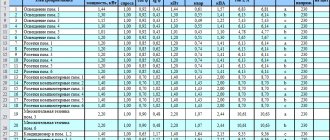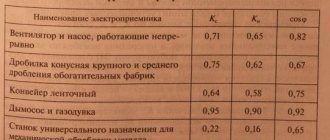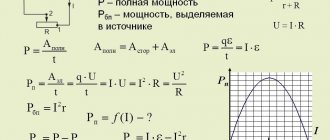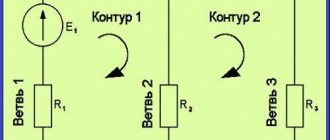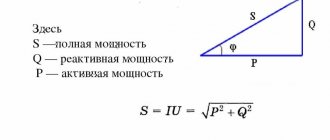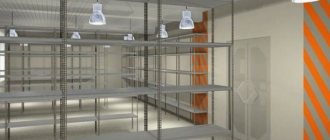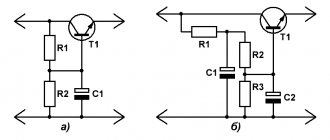Methods for calculating electrical loads
In practical design, there are several such methods for calculating electrical loads using the demand coefficient method:
- calculation of demand coefficient and average power;
- method of specific electricity consumption of specific electrical powers;
- installed capacity method with demand coefficients and - statistical method of calculations;
Example of a power supply project for an industrial enterprise
Back
Forward
If demand coefficients are obtained practically, then the use of this method gives results close to the true values.
Calculation of electrical loads when drawing up a simple power supply diagram using the demand coefficient method is very popular and widespread in calculation engineering and is the simplest method for calculating loads.
Determining the real electrical loads of an energy-consuming facility will give you the opportunity to reasonably and rationally construct technical and economic indicators of power supply systems, determine losses of electricity and power, and select the necessary equipment. Therefore, calculating electrical loads is an important and integral part of organizing the electricity connection of a private or industrial facility.
The results of calculations of electrical loads will influence the technical characteristics of the electrical network and the choice of its elements. Thanks to them, you can ensure the safe operation of electrical networks.
Underestimated results of electrical load calculations lead to overheating of live parts and rapid wear of electrical equipment and materials. And vice versa - an increase in design loads is fraught with additional capital costs for the power supply system and incomplete use of electrical equipment.
When finding the optimal load, various load graph coefficients are used. To find the electrical load using the demand method, you need to know some parameters - the demand coefficients and the total load power of the selected group, as well as the installed power of this group of receivers. In turn, to find the demand coefficient, you need to know the number of electricity consumers operating simultaneously. These calculations can be made using load and concurrency factors.
Based on the obtained calculations of electrical loads for selected groups of consumers, it is possible to calculate the total load of the energy consumption facility. After calculating the total maximum load, the annual electricity consumption of the facility is calculated (for this you need to know the total number of working hours).
What is fire load
This is a quantitative characteristic that shows the probable intensity of combustion and its duration.
By definition, fire load (FL) is the value of the amount of heat emitted or capable of being released into the atmosphere due to the complete combustion of substances, objects, materials located in the flame zone.
When considering the relative value, calculated as PN divided by a unit area, expressed in meters, we talk about the specific fire load (Pud), which has the dimension of megajoule divided by m2, and determines which explosion and fire category a particular room belongs to:
- B4 – Prude from 1 to 180 MJ/m2;
- B3 – Ore within the range of 181–1,400 MJ/m2;
- B2 – Prude from 1,401 to 2,200 MJ/m2;
- B1 – Ore over 2,200 MJ/m2.
In spaces marked B1-B4, the presence of several areas with the specified specific fire load is allowed. If a segment appears with an excess of the parameter Psp relative to the others, the room is assigned an increased hazard code, which corresponds to the maximum value of the specific fire load.
Demand Coefficient Method
The basic calculation formula is: Рр= Кс•Руст ; Qр = Рр×tgφ,
To find the design load of a group of consumers homogeneous in operating mode, use the following expression:
Pp = Kс ×Рн;
Qp = Рp×tgj,
where Kс and tgj are the demand coefficient of the receiver group.
To find the design load of one of the sections of the object or the object itself as a whole, it is necessary to add up the coefficients of different times of load maximums and the design loads of individual groups of receivers.
Calculation using the demand coefficient method has its disadvantages. The main thing is that for all consumers the value of the demand coefficient is assumed to be the same. However, it is assumed to be the same for the optimal number of subscribers.
The demand method is usually used in situations where there is no specific data about the subscriber.
Power load calculation:
Pp = Pmax = Kc* Pset = 0.3 * 16130 = 4839 kW
Qp = tgф * Pp = 0.88 * 4839 = 4258.3 kvar
In addition, it is necessary to take into account the load of artificial lighting in workshops and the plant area.
Below you can use the online calculator to calculate the cost of designing power supply networks:
Classification
Depending on the various indicators of the materials used or placed inside or outside the building, their characteristics, the concept of fire load is further systematized.
Permanent and temporary
The materials from which the structure is constructed, supporting structures, floors, built-in equipment, surface finishes and other non-movable parts of the building constitute a constant fire load.
Replaceable items: papers, finished products, furniture, stands, shields - in general, everything that can be dismantled and removed from the building, even if their weight is several tons, are called temporary PN.
To calculate the specific fire load of a room, the temporary and permanent components are summed up.
By properties and parameters
Classification is also made according to the physical and chemical characteristics of materials and substances, these include:
- The rate of fire spread. Described by the amount of time it takes to obtain one megawatt of power:
- 75 sec. – ultra-fast;
- 150 sec. – fast;
- 300 sec. – average;
- 600 sec. – slow.
- The ability to generate smoke is determined by optical density:
- over 500 m2/kg – high;
- 50–500 m2/kg – moderate;
- up to 50 m2/kg – small.
- Density. Standard values are within the range of 300–2,000 MJ/m2.
- Toxicity. It is determined by comparing the amount of gases released during a fire with the harmfulness indicator given as the ratio of the density of toxic suspensions in the atmosphere to the maximum permissible concentration of the substance in the air.
Economic efficiency
The main task of economic efficiency is to find a power supply option in which losses in the network will be minimal, performance indicators will be better and will ensure a high degree of reliability.
The minimum of the given costs is the main criterion for the efficiency of the power supply system. It is determined by the formula, thousand monetary units per year (thousand monetary units/year):
(1)
where pnorm = 0.12 is the standard efficiency ratio of capital investments; K - one-time capital investments, thousand monetary units/year; - annual operating costs during normal operation, thousand monetary units/year; ra, rt.R - coefficients of deduction for current repairs and depreciation; Ie—electricity losses, thousand monetary units/year; p is the coefficient of total deductions from capital investments.
The total reduced costs can be used as a criterion for profitability, thousand monetary units/year:
(2)
The results of technical and economic calculations are not affected by which formula (1) or (2) is used, since for comparing options, the ratio of costs is important, not their value.
Example 1
Economic indicators of the three compared options, thousand monetary units: K1 = 100, I1 = 30; K2 = 150, I2 = 18; K3 = 200, I3 = 24. It is necessary to determine the most economical option of the three.
When calculating annual reduced costs, thousand monetary units/year, using formula (1) we obtain: Zg = 0.12 * 100 + 30 = 42; 32 = 0.12 * 150 + 18 = 36; Z3 = 0.12 * 200 + 24 = 48.
When calculating the total costs, thousand monetary units, using formula (2) we find: 312 = = 30/0.12+ 100 = 340, 322 = 18/0.12 + 150 = 300, = 24/0.12 + 200 = 400. Thus, in both cases, option 2 turned out to be the most economical.
Typical cable size selection
In accordance with the cable cross-section, automatic switches are used. The classic version of the wire cross-section is most often used:
- For lighting circuits with a cross section of 1.5 mm2;
- For socket circuits with a cross section of 2.5 mm2;
- For electric stoves, air conditioners, water heaters – 4 mm2;
To bring power into the apartment, a 10 mm2 cable is used, although in most cases 6 mm2 is enough. But the cross section of 10 mm2 is chosen with a reserve, so to speak, with the expectation of a larger number of electrical appliances. Also, a general RCD with a shutdown current of 300 mA is installed at the input - its purpose is fire protection, since the shutdown current is too high to protect a person or animal.
To protect people and animals, an RCD with a shutdown current of 10 mA or 30 mA is used directly in potentially unsafe rooms, such as a kitchen, bathroom, and sometimes room groups of sockets. The lighting network, as a rule, is not supplied with an RCD.
Size for different types of premises
In buildings, the fire load depends on density and is determined separately for each floor, taking into account the purpose of the space.
Table of specific fire load of materials for premises of various uses.
| Purpose | Permissible fire load value |
| Administrative, domestic, office space | 50 kg/m2 |
| Apartment, number of rooms 1 2 3 | 27 kg/m2 30 kg/m2 40 kg/m2 |
| Structure, fire resistance degree III | 100 kg/m2 |
| Workshop at an enterprise | 500 kg/m2 |
| Drying chambers, warehouses | 1,500 kg/m2 |
| Petroleum products processing workshops | 3,000 kg/m2 |
| Warehouse complexes with high-level storage on racks | 3,000 kg/m2 |
The calculation of PN is made taking into account the density of placement of raw materials and materials. The location on the floor, racks, and pallets is taken into account.
GOST 12.1.004-91 establishes the mandatory classification of objects by fire hazard, taking into account PN.
Initial data for calculation
As initial data, we assume that we need to calculate the loads for the office panel:
- The office has 6 rooms;
- Lighting using lamps with fluorescent lamps;
- The socket network for computers and “household” consumers is made separately;
- The office has air conditioning;
- The office has a dining room with a kettle, microwave, refrigerator and TV.
We distribute consumers into groups and fill out the calculation table.

